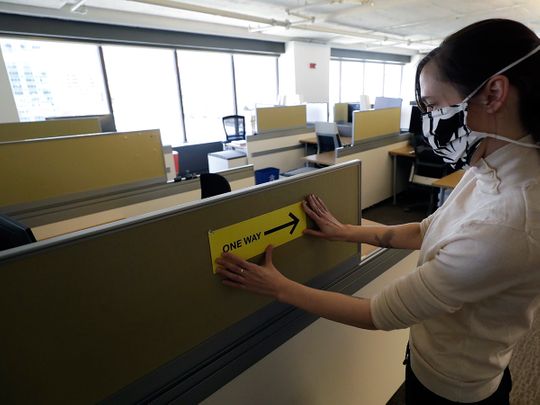
The amount of office space per employee has been contracting for decades.
However, this metric may have to increase for the first time as we rethink every aspect of office life, from busy lunchrooms to public restrooms. In offices where layouts prevent proper distancing, there may be rotating shifts to keep office density to a minimum. Technological models can help organizations better understand what portion of their portfolios needs to serve as long-term space and what portion is flexible and available for the short-term.
It is important for firms to already be devising answers to the question of why employees go to an office and how often and for how long they should. With more enhanced tech capabilities such as clear and concise platforms for messaging as well as a reformation in company culture that values trust and output versus physical presence, companies can quickly adapt to this new environment.
Mindset shifts
In the wake of the COVID-19 pandemic, firms that may have been hesitant to adapt now have to pivot quickly to remain competitive. Property managers can aid in helping occupiers and developers adapt their space to accommodate the needs of current and future tenants. Brought on by the pandemic, offices will be adopting newer technologies to reduce common touchpoints.
Some tenants and landlords were beginning to track office usage with sensors, which determined heavily trafficked areas even before COVID-19. Beyond the outbreak, these same sensors could be used to monitor, track and determine which areas are most in need of deep cleaning, where density is too high, and which workstations are underused and could perhaps be repurposed.
No ditching the office
While the physical workplace is undergoing changes due to a range of evolving factors, the need for physical space will be ever present. Many global benchmarks and trends were already focused on the need for wellbeing such as open spaces for relaxation, technologies to reduce interactions and improve efficiencies and areas for meeting and small-scale collaboration.
Reaffirming the importance of these aspects and redefining what individual workspaces within the office looks like will be top-of-mind for developers, owners and occupiers during this period.
Taking in global trends
The internal characteristics of buildings are increasingly important, as tenants look for highly serviced, amenity-rich spaces that are also enabled with tech functions that either increase efficiency or enhance the environment.
Other elements such as hospitality and concierge-style services are also increasingly featuring within new office spaces. Dubai-based tenants who are consolidating offices or fulfilling expansion plans often use the move as an opportunity to implement or further global workplace trends and practices.
Likewise, personal delivery points and employee convenience apps are becoming common features. Smart Dubai has created the Smart Employee App, which allows managers to access and manage their work list, monitor time management, and view and manage their leave availability.
The adoption of hygienic security measures that reduce human contact are being immediately adopted. As we try to mitigate the spread of the virus, investments in this arena would be wise for developers to avoid any similar occurrences.
- Gabriella De La Torre is Director - Consulting at CBRE.








